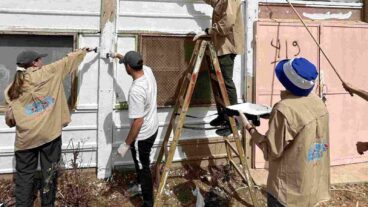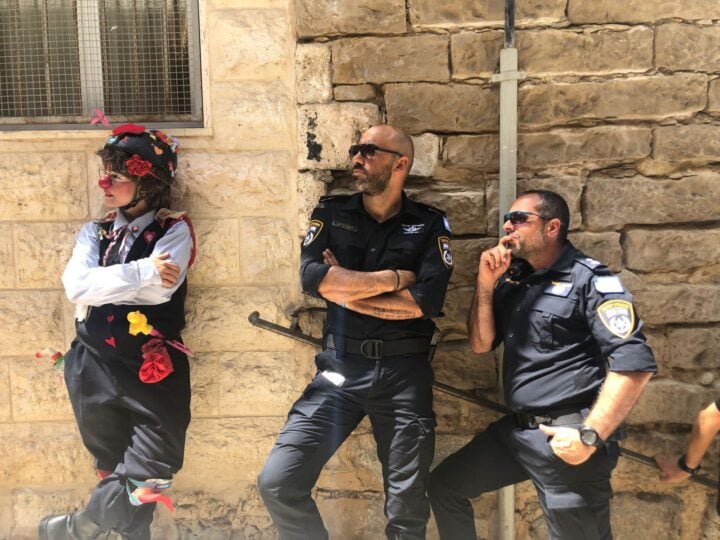When news got out in November 2013 that the Israel Defense Forces had set up a field hospital in Bogo City in the wake of the devastating Typhoon Haiyan in the Philippines, hundreds of people rushed there for medical help.
For some it was the first medical care they had ever received. Over a period of nearly two weeks, the IDF medical team treated 2,686 patients, including 838 children. Some were victims of the typhoon; others were suffering from chronic illnesses.
The category 5 Typhoon Haiyan was one of the strongest tropical cyclones ever recorded worldwide. It devastated portions of Southeast Asia, and in particular the Philippines, where 6,300 people were killed, 27,000 injured and some four million left homeless.
Israel was among the first countries to send support to the ravaged archipelago. Within hours, Israeli medical professionals and aid workers, as well as government officials and a first-responder Home Front command team, set out to offer assistance.
The 150-strong IDF delegation included medical staff and search-and-rescue units. In two weeks, the field hospital performed 60 operations, including cancer and eye surgeries, and delivered 36 babies. The first baby born at the hospital was named Israel by his grateful parents.

The IDF also distributed meals, repaired schools and other infrastructure damaged by the storm, and provided trauma counseling to local teachers. Two Filipino children with cleft palates were flown to Israel for treatment.
In an article published in the aftermath of the disaster, Dr. Nancy Snyderman, an NBC correspondent on the scene in the Philippines, wrote: “I asked the IDF Surgeon General in charge why they chose Bogo. He said it was because they were poor and their needs were great. As I left, I walked away in awe of this group of doctors: physician humanitarians, and medicine at its very best.”
Israeli relief organization IsraAID arrived in the country two days after the typhoon, set up a field hospital and provided medical, trauma and humanitarian aid to more remote areas.
Israel has a long history of sending lifesaving aid abroad in the wake of some of the world’s most catastrophic storms and floods. Examples include:
Hurricane Matthew, October 2016:
Following the hurricane that killed about 900 people and injured or displaced 350,000 others as it destroyed houses, villages, roads, bridges and other infrastructure, IsraAID and local partner Prodev were the first to provide food and water for 200 children at Cite Soleil, a densely populated and impoverished community in Port-Au-Prince.

Flooding and landslides, Sri Lanka; May 2016:
The Israeli government sent vital supplies to Sri Lanka after heavy rains triggered deadly floods and landslides across most of the country.

Cyclone Winston, Fiji; March 2016:
Israeli volunteers rushed to Fiji in the wake of a category 5 cyclone that killed 44, and left 40% of the population impacted by the storm. Supported by the Israeli Foreign Ministry and the Israel Embassy in Australia, Israeli volunteers from IsraAid brought emergency aid in the form of relief supplies, building and sanitation expertise, psychosocial and educational programs.
Flooding, Uruguay and Paraguay; January 2016:
The Israeli embassies in Uruguay and Paraguay sent humanitarian relief supplies to help hundreds of families displaced after severe flooding in both countries.
Flooding, United Kingdom; January 2016:
IsraAID volunteers flew to Leeds, UK, to help repair homes and distribute blankets and food after severe flooding hit the north of England.
Flooding, the Carolinas; Oct 2015:
IsraAID sent a team of Israeli humanitarian relief experts to North and South Carolina to help clean up the wreckage after record-breaking rainstorms flooded swaths of the two US states.
Flooding, Myanmar; August 2015:
With the cooperation of MASHAV, Israel’s Agency for International Development Cooperation, the Israeli Embassy in Myanmar sent a truckload of food, medicines and hygiene packs to flood-ravaged areas after monsoons led to severe flooding and landslides and displaced nearly 1.3 million people.
Tornado, Illinois; July 2015:
IsraAID sent a team of Israeli volunteers to help gut and fix homes destroyed by a tornado that ripped through Coal City, Illinois. The tornado packed winds of up to 160mph and destroyed 884 properties.
Flooding, Texas; May 2015:
IsraAID sent a team of volunteers to flood-ravaged Texas to help relief efforts in Wimberley, and to lay the groundwork for rehabilitation and reconstruction initiatives.

Cyclone Pam, Vanuatu; March 2015
Two days after a category 5 cyclone hit the archipelago of Vanuatu, the nation declared a state of emergency and called for international help. IsraAid responded to the call, sending an emergency relief team to the area with supplies of food and water.
Typhoon Ruby, the Philippines; December 2014:
Israeli emergency response teams provided medical, psychological and social support to the Philippines after Typhoon Ruby, which left hundreds of thousands of families homeless. Israeli aid workers also distributed relief packages to the many people displaced by the storm.
Flooding, Serbia and Bosnia; May 2014:
Israeli NGO Lev Echad (One Heart) sent trauma aid to Serbia and Bosnia after the worst flooding in 120 years killed dozens and left thousands homeless. The Israel Defense Forces sent 1.5 million tons of medical and humanitarian aid to the region, including medicine, food and blankets. IsraAID dispatched teams of medical, trauma and relief professionals to the two countries.
Typhoon Haiyan, the Philippines; November 2013:
Israel sent a large aid team to the Philippines in the wake of Typhoon Haiyan, one of the worst storms to make landfall on record. The country saw 6,300 people killed in the superstorm, and millions left homeless.
Israeli first responders included Israel’s Foreign Ministry, the IDF, IsraAID and FIRST. Medical staff, search-and-rescue experts and trauma specialists were all sent to the country, setting up field hospitals in badly hit areas.

Hurricane Sandy, US; November 2012:
Israeli volunteers rushed to help with cleanup efforts after a hurricane in New York and New Jersey left thousands of people without electricity, food, water or shelter.
Israeli Flying Aid delivered fuel to county hospitals, and NGOs Latet and IsraAID sent teams of rescue workers to help with relief efforts. The aid was financed primarily by young Israelis and Israeli companies.
In the wake of the storm, the White House and the Federal Emergency Management Agency (FEMA) turned to Israeli crowdsourcing company Waze for help directing New Jersey residents where to fuel up.

Other notable Israeli aid delegations include those sent to the Philippines in 2009 following Typhoon Parma; to Myanmar in 2008 after Cyclone Nargis; and to New Orleans in the wake of 2005’s Hurricane Katrina.
To view more stories on Israel’s exceptional humanitarian aid efforts abroad in the My Name is Israel aid exhibition, or to download the exhibit for display, click here.

















